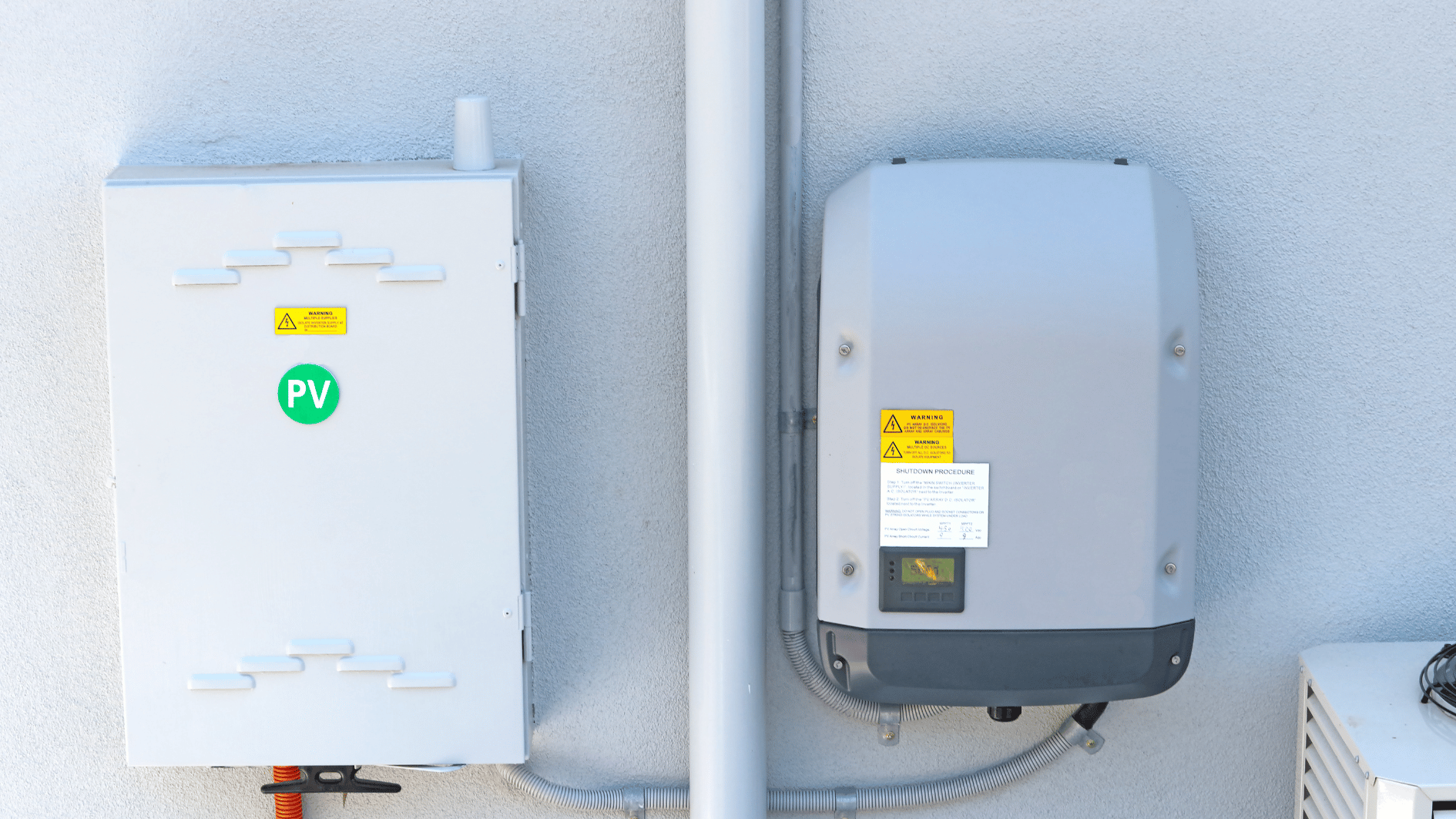Image source: Canva.com
When exploring solar energy storage options, one common question that arises is whether all batteries come equipped with built-in inverters. Inverters play a crucial role in solar energy systems, converting the direct current (DC) generated by solar panels into alternating current (AC) used by most household appliances. The presence of a built-in inverter in a battery can simplify installation and integration with your existing solar setup. However, not all batteries include this feature, and understanding the differences can help you make an informed decision.
This article will help you explore the various types of solar batteries, explaining the role of inverters and why some batteries come with them while others do not. We’ll look into the benefits and potential drawbacks of batteries with built-in inverters, as well as what you need to consider if you opt for a battery without one. Whether you’re new to solar energy or looking to upgrade your current system, this article will provide the insights needed to choose the right battery for your specific needs.
Batteries Without Built-In Inverters
Batteries without built-in inverters are energy storage devices that store electricity in its direct current (DC) form but do not have the capability to convert that DC electricity into alternating current (AC), which is the standard form of electricity used by most household appliances and the electrical grid. Because these batteries lack an inverter, they require an external inverter to perform this conversion if they are to be integrated into a solar energy system or used for home backup power.
Examples
Tesla Powerwall (early versions)
Tesla’s Powerwall initially came as a battery-only option without an integrated inverter. Homeowners needed to pair it with a compatible inverter to convert the stored DC electricity into AC for home use.
LG Chem RESU
This popular home battery storage option also comes without a built-in inverter, offering flexibility in pairing with different types of inverters depending on the specific needs of the solar energy system.
Sonnen Eco (some models)
While some Sonnen batteries come with integrated inverters, certain models are designed to be paired with external inverters, allowing for more customized energy solutions.

Use Case Considerations
Choosing a battery without a built-in inverter can offer greater flexibility, particularly if you’re integrating the battery into an existing solar system where you may already have a compatible inverter. It also allows for more customization in system design, such as selecting a high-efficiency inverter that matches the specific requirements of your home or business.
However, it’s important to note that adding an external inverter can increase the complexity and cost of installation. If simplicity and ease of integration are priorities, you might prefer a battery with a built-in inverter, which streamlines the installation process and reduces the need for additional components.
Energy Storage Systems with Inverters
Energy storage systems with built-in inverters are advanced solutions that combine energy storage and conversion technology in a single unit. These systems integrate an inverter into the battery unit, allowing for the direct conversion of direct current (DC) electricity—stored in the battery—into alternating current (AC) electricity, which is the standard form used by most household appliances and the electrical grid. This integration simplifies the overall system design, reduces the number of components needed, and can streamline installation.
Examples
Tesla Powerwall 2
The Tesla Powerwall 2 is a prominent example of a battery with a built-in inverter. This system combines high-capacity energy storage with an integrated inverter, making it a straightforward option for home energy storage. The Powerwall 2 supports both backup power and grid-tied solar applications, and its built-in inverter facilitates seamless integration with residential electrical systems.
Enphase Encharge
Enphase Encharge batteries come with built-in microinverters, which handle the DC to AC conversion. The Encharge system is designed to work seamlessly with Enphase microinverters used in solar panel installations, providing a cohesive and efficient energy storage solution for residential solar systems.
SonnenBatterie
The SonnenBatterie series, particularly the SonnenBatterie Eco, integrates a high-performance inverter within the battery unit. This design allows the SonnenBatterie to convert stored DC energy into usable AC power efficiently, making it suitable for both backup power and self-consumption in solar-powered homes.

Advantages
- Systems with built-in inverters reduce the need for additional components, making the installation process more straightforward and potentially less expensive.
- Combining the battery and inverter into one unit saves space and can reduce the overall footprint of the energy storage system.
- Fewer components mean less complexity in system design and fewer points of potential failure, leading to a more reliable setup.
Considerations
While energy storage systems with integrated inverters offer many benefits, it’s essential to consider factors such as compatibility with existing solar setups, the efficiency of the built-in inverter, and any potential limitations related to the combined unit. These systems are well-suited for homeowners looking for an all-in-one solution that simplifies both the installation and operation of their energy storage system.
Energy Storage Systems with Hybrid Inverters
Energy storage systems with hybrid inverters integrate both battery storage and inverter functionality into a single unit, but with an added feature: they are designed to handle both solar energy conversion and battery management. This hybrid approach allows the system to manage the conversion of direct current (DC) electricity from solar panels to alternating current (AC) for household use, as well as the management of energy stored in batteries. Hybrid inverters offer a versatile solution for integrating solar power with energy storage, making them suitable for grid-tied, off-grid, or backup power applications.
Examples
SolarEdge Energy Hub
The SolarEdge Energy Hub is a hybrid inverter system that combines solar power conversion with battery storage management. It integrates seamlessly with SolarEdge’s battery solutions, enabling efficient energy management by converting solar DC electricity to AC for use in the home and managing energy storage for later use or backup power.
Fronius Symo Hybrid
The Fronius Symo Hybrid is a hybrid inverter designed to work with both solar panels and battery storage. It supports the conversion of solar energy to AC power and integrates with a battery system to store excess energy. This hybrid approach provides flexibility for residential solar installations, allowing homeowners to optimize their energy usage and storage.
SMA Sunny Boy Storage
The SMA Sunny Boy Storage inverter offers a hybrid solution for solar energy and battery storage. It enables the conversion of solar-generated DC electricity into AC power for household use and manages the charging and discharging of connected batteries. The SMA Sunny Boy Storage system is known for its reliability and compatibility with various battery brands.

Advantages
- Hybrid inverters manage both solar energy conversion and battery storage, providing a unified system that simplifies energy management and improves overall efficiency.
- These systems are suitable for various applications, including grid-tied, off-grid, and backup power setups. They offer the flexibility to optimize energy use based on the specific needs of the household or business.
- Combining the functions of a solar inverter and battery management into one unit reduces the need for multiple components, saving space and streamlining the installation process.
- Hybrid inverters provide advanced control features, allowing users to monitor and manage their energy consumption and storage more effectively through integrated software and monitoring platforms.
Considerations
When choosing a hybrid inverter system, it’s important to consider factors such as compatibility with existing solar panels and batteries, the efficiency of the inverter, and the system’s capacity to meet your energy needs. Hybrid inverters offer a comprehensive solution for managing solar energy and storage, making them an attractive option for those seeking an integrated approach to energy management.
Flexible Storage Systems: Options With or Without Integrated Inverters
Several storage systems on the market today can be purchased with or without an integrated inverter, offering flexibility for different applications and system designs.
Tesla
Tesla, the best-known storage manufacturer, provides its Powerwall 2 in two varieties: one with an integrated inverter and one without. This flexibility allows installers to choose the best option for their specific needs.
Standalone Storage System
For applications like Green Mountain Power’s pilot program, the Powerwall 2 with an integrated inverter is ideal.
DC-Coupled Solar Plus Storage System
For systems where DC coupling is preferred, there is a Powerwall 2 option without an integrated inverter.
However, it’s important to note that only the Powerwall 2 with the built-in inverter is commercially available in the US market. This means that for installations involving a solar panel system, you’ll need to pair the Powerwall 2 with an external inverter since it requires AC electricity as the input. This can decrease the overall system efficiency of solar + storage systems, as is the case with other batteries that have an integrated storage inverter.
Receive Battery Storage Quotes on SolarWiki Today!
If you’re interested in comparing your options for adding storage to a solar panel system, we can help! We’ll get quotes on your behalf from solar companies in your area. Happy solar shopping!





